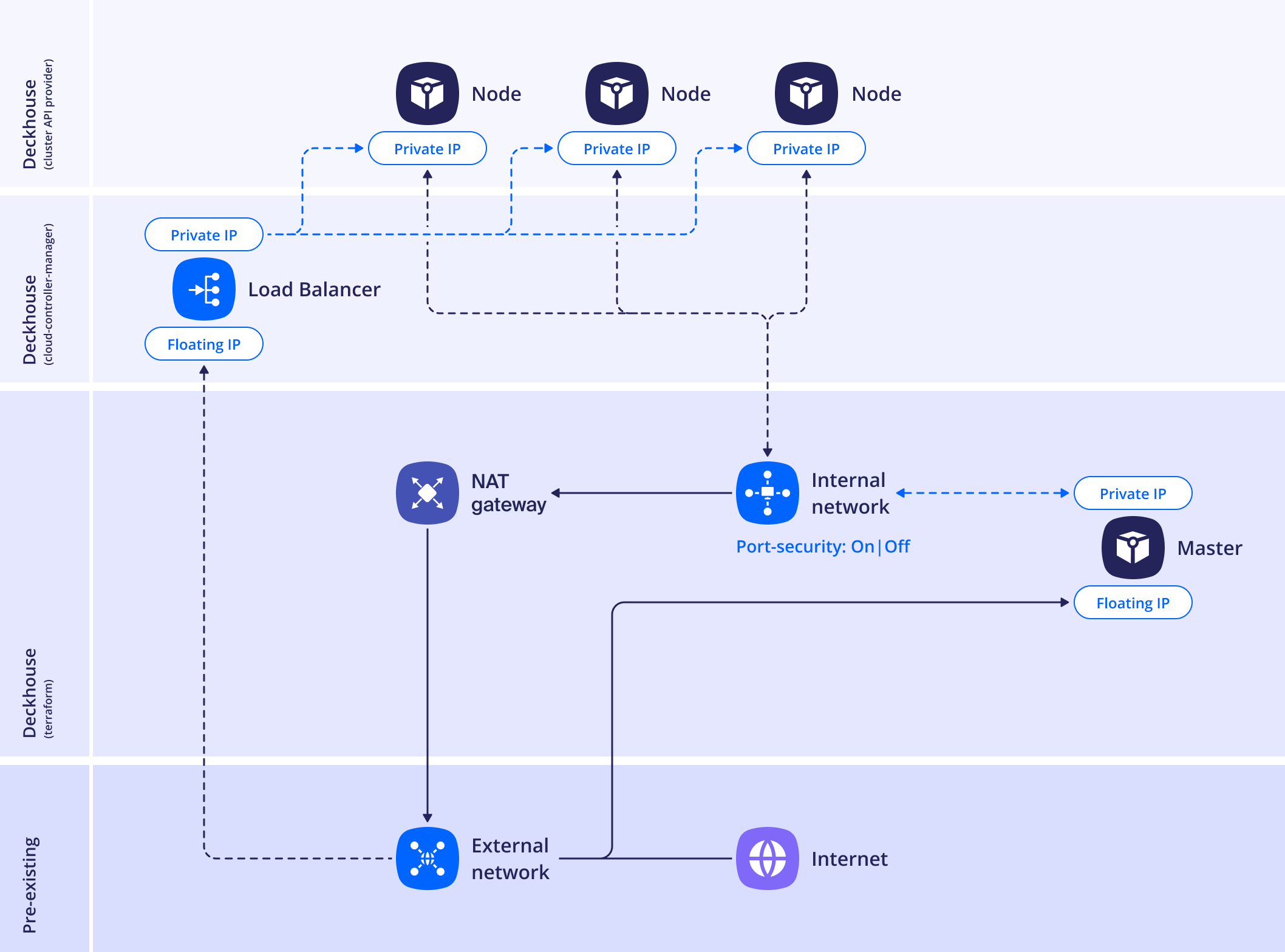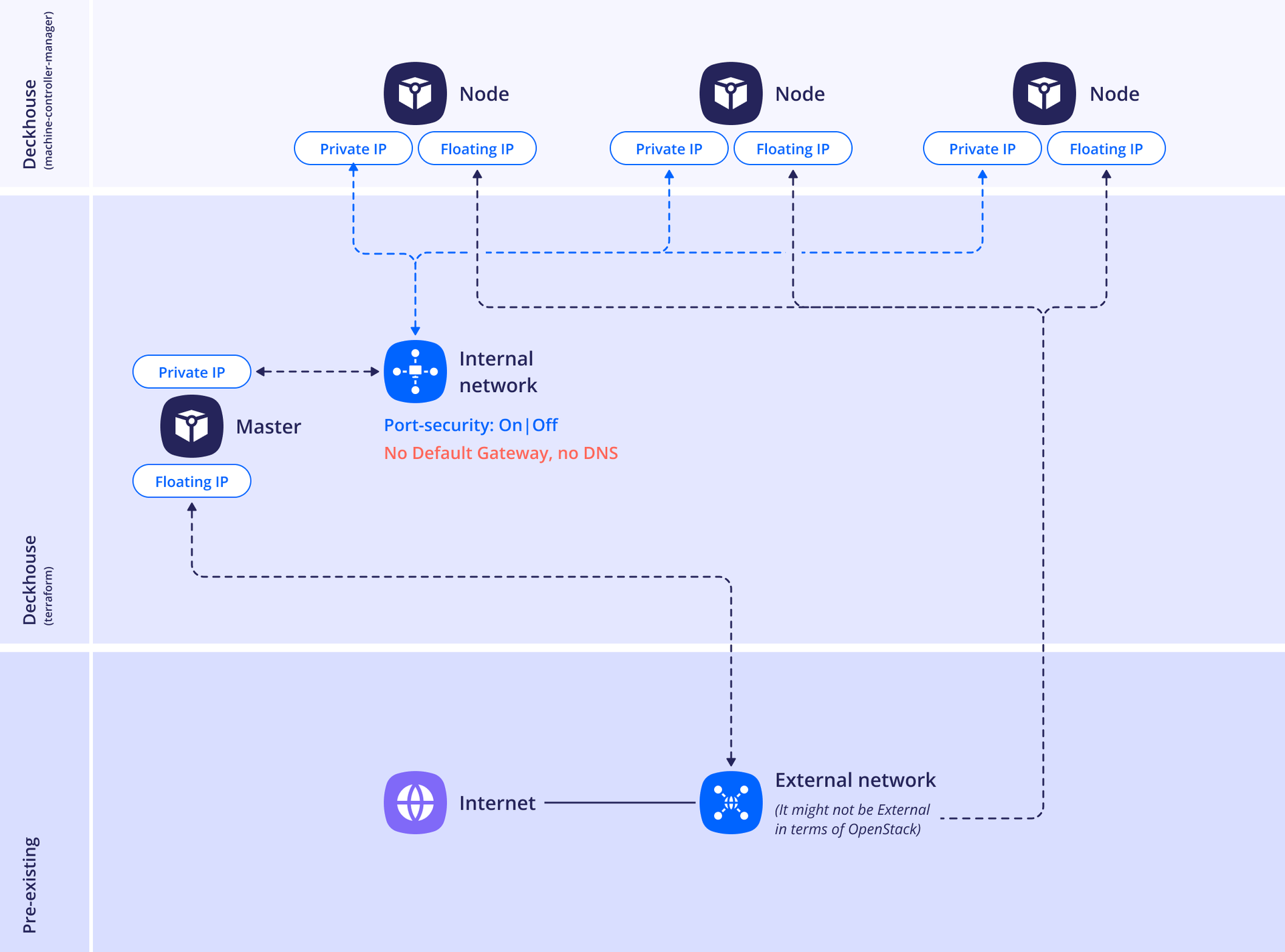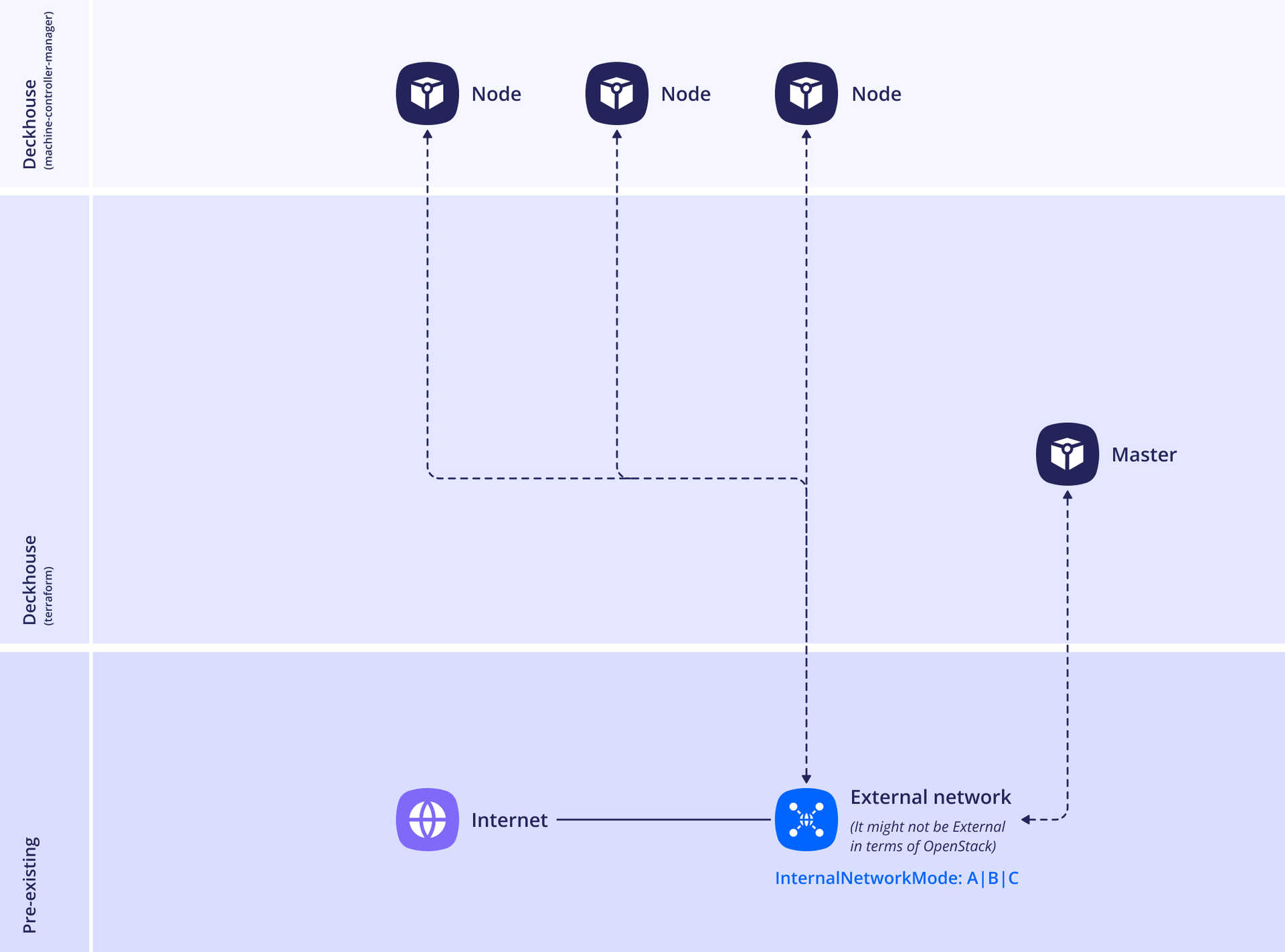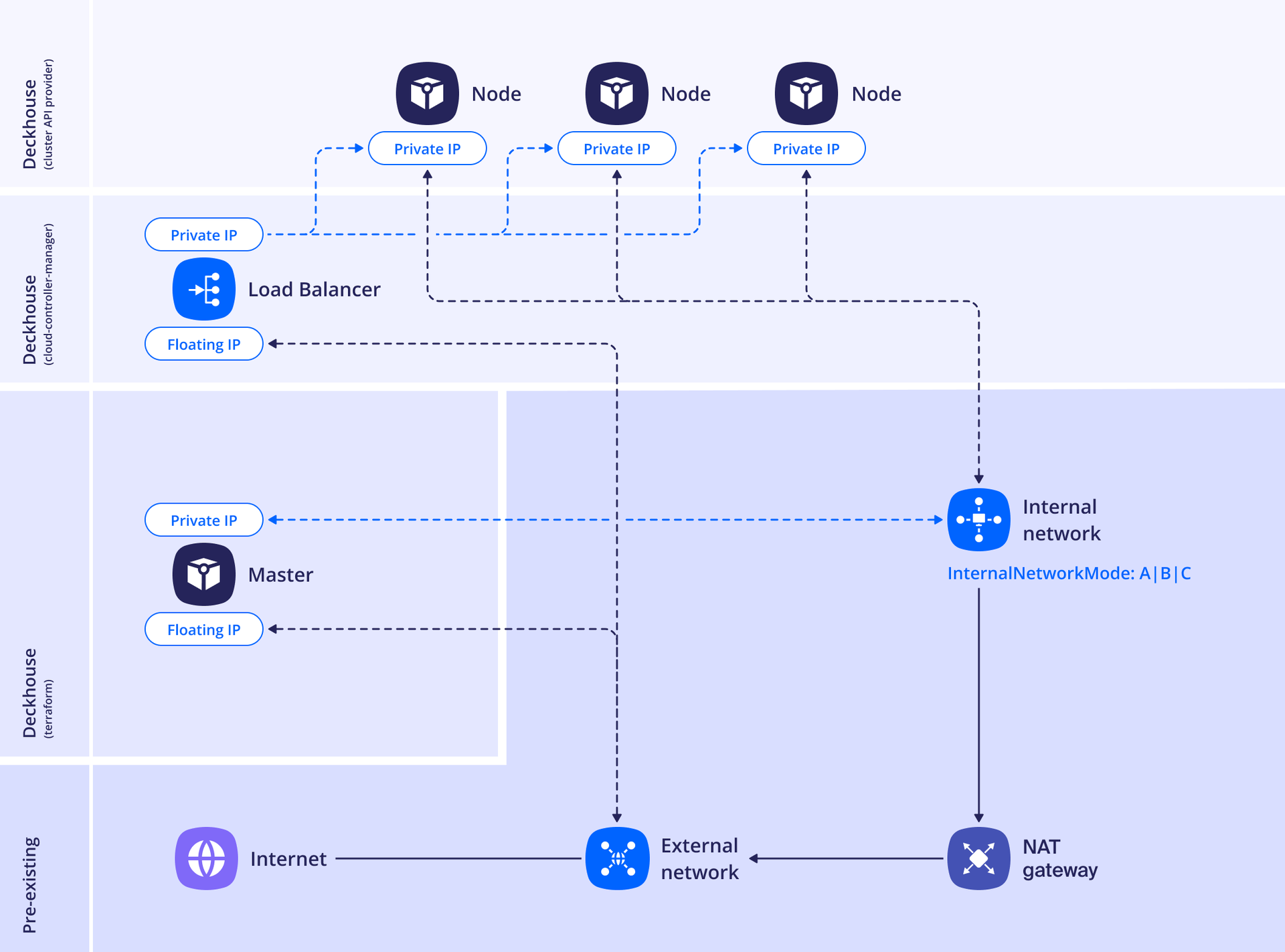The module lifecycle stage: General Availability
Four layouts are supported. Below is more information about each of them.
Standard
In this scheme, an internal cluster network is created with a gateway to the public network; the nodes do not have public IP addresses. Note that the floating IP is assigned to the master node.
Caution! If the provider does not support SecurityGroups, all applications running on nodes with Floating IPs assigned will be available at a public IP. For example,
kube-apiserveron master nodes will be available on port 6443. To avoid this, we recommend using the SimpleWithInternalNetwork placement strategy or Standard strategy with bastion host.

Example of the layout configuration:
apiVersion: deckhouse.io/v1
kind: OpenStackClusterConfiguration
layout: Standard
standard:
internalNetworkCIDR: 192.168.199.0/24 # Required.
internalNetworkDNSServers: # Required.
- 8.8.8.8
- 4.2.2.2
internalNetworkSecurity: true|false # Optional, default true.
externalNetworkName: shared # Required.
bastion:
zone: ru2-b # Optional.
volumeType: fast-ru-2b # Optional.
instanceClass:
flavorName: m1.large # Required.
imageName: ubuntu-20-04-cloud-amd64 # Required.
rootDiskSize: 50 # Optional, default 50 gigabytes.
additionalTags:
severity: critical # Optional.
environment: production # Optional.
masterNodeGroup:
replicas: 3
instanceClass:
flavorName: m1.large # Required.
imageName: ubuntu-18-04-cloud-amd64 # Required.
# Optional, local disk is used if not specified.
rootDiskSize: 50
# Optional, additional security groups.
additionalSecurityGroups:
- sec_group_1
- sec_group_2
additionalTags:
severity: critical
environment: production
# Required, volume type map for etcd and kubernetes certs
# (always use fastest disk supplied by provider).
volumeTypeMap:
# If rootDiskSize specified than this volume type will
# be also used for master root volume.
ru-1a: fast-ru-1a
ru-1b: fast-ru-1b
ru-1c: fast-ru-1c
nodeGroups:
- name: front
replicas: 2
instanceClass:
flavorName: m1.small # Required.
imageName: ubuntu-18-04-cloud-amd64 # Required
# Optional, local disk is used if not specified.
rootDiskSize: 20
# Optional, default false, determines if config drive is
# required during vm bootstrap process. It's needed if there
# is no dhcp in network that is used as default gateway.
configDrive: false
# Required, the gateway of the network will be used as the default gateway.
# Matches the cloud.prefix in the ClusterConfiguration resource.
mainNetwork: kube
additionalNetworks: # Optional.
- office
- shared
# Optional, if there are networks with disabled port
# security their names must be specified.
networksWithSecurityDisabled:
- office
# Optional, list of network pools where to order floating IPs.
floatingIPPools:
- public
- shared
# Optional, additional security groups.
additionalSecurityGroups:
- sec_group_1
- sec_group_2
zones:
- ru-1a
- ru-1b
sshPublicKey: "<SSH_PUBLIC_KEY>"
tags:
project: cms
owner: default
provider:
...
StandardWithNoRouter
An internal cluster network is created that does not have access to the public network. All nodes (including master ones) have two interfaces: the first one to the public network, the second one to the internal network. This layout should be used if you want all nodes in the cluster to be directly accessible.
Caution! This strategy does not support a LoadBalancer since a Floating IP is not available for the router-less network. Thus, you cannot provision a load balancer with the Floating IP. An internal load balancer with the virtual IP in the public network is only accessible to cluster nodes.
Caution! In this strategy, it is necessary to explicitly specify the name of the internal network in
additionalNetworkswhen creating anOpenStackInstanceClassin the cluster.

Example of the layout configuration:
apiVersion: deckhouse.io/v1
kind: OpenStackClusterConfiguration
layout: StandardWithNoRouter
standardWithNoRouter:
internalNetworkCIDR: 192.168.199.0/24 # Required.
externalNetworkName: ext-net # Required.
# Optional, whether dhcp is enabled in specified external
# network (default true).
externalNetworkDHCP: false
internalNetworkSecurity: true|false # Optional, default true.
masterNodeGroup:
replicas: 3
instanceClass:
flavorName: m1.large # Required.
imageName: ubuntu-18-04-cloud-amd64 # Required.
# Optional, local disk is used if not specified.
rootDiskSize: 50
# Optional, additional security groups.
additionalSecurityGroups:
- sec_group_1
- sec_group_2
# Required, volume type map for etcd and kubernetes certs
# (always use fastest disk supplied by provider).
volumeTypeMap:
# If rootDiskSize specified than this volume type will
# be also used for master root volume.
nova: ceph-ssd
nodeGroups:
- name: front
replicas: 2
instanceClass:
flavorName: m1.small # Required.
imageName: ubuntu-18-04-cloud-amd64 # Required.
# Optional, local disk is used if not specified.
rootDiskSize: 20
# Optional, default false, determines if config drive
# is required during vm bootstrap process. It's needed
# if there is no dhcp in network that is used as default
# gateway.
configDrive: false
# Required, the gateway of the network will be used as the default gateway.
# Matches the cloud.prefix in the ClusterConfiguration resource.
mainNetwork: kube
additionalNetworks: # Optional.
- office
- shared
# Optional, if there are networks with disabled port
# security their names must be specified.
networksWithSecurityDisabled:
- office
# Optional, list of network pools where to order floating IPs.
floatingIPPools:
- public
- shared
# Optional, additional security groups.
additionalSecurityGroups:
- sec_group_1
- sec_group_2
# Required if rootDiskSize is specified. Volume type map for node's root volume
volumeTypeMap:
nova: ceph-ssd
sshPublicKey: "<SSH_PUBLIC_KEY>"
provider:
...
Simple
The master node and cluster nodes are connected to the existing network. This placement strategy might come in handy if you need to merge a Kubernetes cluster with existing VMs.
Caution! This strategy does not support a LoadBalancer since a Floating IP is not available for the router-less network. Thus, you cannot provision a load balancer with the Floating IP. An internal load balancer with the virtual IP in the public network is only accessible to cluster nodes.

Example of the layout configuration:
apiVersion: deckhouse.io/v1
kind: OpenStackClusterConfiguration
layout: Simple
simple:
externalNetworkName: ext-net # Required.
externalNetworkDHCP: false # Optional, default true.
# Optional, by default VXLAN, may also be DirectRouting
# or DirectRoutingWithPortSecurityEnabled.
podNetworkMode: VXLAN
masterNodeGroup:
replicas: 3
instanceClass:
flavorName: m1.large # Required.
imageName: ubuntu-18-04-cloud-amd64 # Required.
# Optional, local disk is used if not specified.
rootDiskSize: 50
# Optional, additional security groups.
additionalSecurityGroups:
- sec_group_1
- sec_group_2
# Required, volume type map for etcd and kubernetes certs
# (always use fastest disk supplied by provider).
volumeTypeMap:
# If rootDiskSize specified than this volume type will
# be also used for master root volume.
nova: ceph-ssd
nodeGroups:
- name: front
replicas: 2
instanceClass:
flavorName: m1.small # Required.
imageName: ubuntu-18-04-cloud-amd64 # Required.
# Optional, local disk is used if not specified.
rootDiskSize: 20
# Optional, default false, determines if config drive
# is required during vm bootstrap process. It's needed
# if there is no dhcp in network that is used as default
# gateway.
configDrive: false
# Required, network will be used as default gateway.
# Matches the name of the pre-created network.
mainNetwork: kube
additionalNetworks: # Optional.
- office
- shared
# Optional, if there are networks with disabled port
# security their names must be specified.
networksWithSecurityDisabled:
- office
# Optional, list of network pools where to order floating IPs.
floatingIPPools:
- public
- shared
# Optional, additional security groups.
additionalSecurityGroups:
- sec_group_1
- sec_group_2
sshPublicKey: "<SSH_PUBLIC_KEY>"
provider:
...
SimpleWithInternalNetwork
The master node and cluster nodes are connected to the existing network. This placement strategy might come in handy if you need to merge a Kubernetes cluster with existing VMs.
Caution! This placement strategy does not involve the management of
SecurityGroups(it is assumed they were created beforehand). To configure security policies, you must explicitly specify bothadditionalSecurityGroupsin theOpenStackClusterConfigurationfor the masterNodeGroup and other nodeGroups, andadditionalSecurityGroupswhen creatingOpenStackInstanceClassin the cluster.

Example of the layout configuration:
apiVersion: deckhouse.io/v1
kind: OpenStackClusterConfiguration
layout: SimpleWithInternalNetwork
simpleWithInternalNetwork:
# Required, all cluster nodes have to be in the same subnet.
internalSubnetName: pivot-standard
# Optional, by default DirectRoutingWithPortSecurityEnabled,
# may also be DirectRouting or VXLAN.
podNetworkMode: DirectRoutingWithPortSecurityEnabled
# Optional, if set will be used for load balancer default
# configuration and ordering master floating IP.
externalNetworkName: ext-net
# Optional, default value is true.
masterWithExternalFloatingIP: false
masterNodeGroup:
replicas: 3
instanceClass:
flavorName: m1.large # Required.
imageName: ubuntu-18-04-cloud-amd64 # Required.
# Optional, local disk is used if not specified.
rootDiskSize: 50
# Optional, additional security groups.
additionalSecurityGroups:
- sec_group_1
- sec_group_2
# Required, volume type map for etcd and kubernetes certs
# (always use fastest disk supplied by provider).
volumeTypeMap:
# If rootDiskSize specified than this volume type will
# be also used for master root volume.
nova: ceph-ssd
nodeGroups:
- name: front
replicas: 2
instanceClass:
flavorName: m1.small # Required.
imageName: ubuntu-18-04-cloud-amd64 # Required.
# Optional, local disk is used if not specified.
rootDiskSize: 20
# Optional, default false, determines if config drive
# is required during vm bootstrap process. It's needed
# if there is no dhcp in network that is used as default
# gateway.
configDrive: false
# Required, network will be used as default gateway.
# Matches the name of the pre-created network.
mainNetwork: kube
additionalNetworks: # Optional.
- office
- shared
# Optional, if there are networks with disabled port
# security their names must be specified.
networksWithSecurityDisabled:
- office
# Optional, list of network pools where to order floating IPs.
floatingIPPools:
- public
- shared
# Optional, additional security groups.
additionalSecurityGroups:
- sec_group_1
- sec_group_2
sshPublicKey: "<SSH_PUBLIC_KEY>"
provider:
...